The Town of Cerdon in Early Society of Mary History
by the Editor
Fr Jean-Claude Colin at Cerdon
The town of Cerdon was a journey of some 20 hours from Lyons by stage coach in Fr Colin’s time. The town is about 70 kilometres north-east of Lyons, and much the same distance south-west of Geneva. Since Roman times the road between Lyons and Geneva, important cities, passed through Cerdon.
As well as being in a wine-growing area, the town featured two mills and a paper factory. Most of the population in the early 1800s were either farmers or wine-growers, or both. Some were paper manufacturers, wine-makers and proprietors; others were a mix of the various trades that towns needed: tailors, bakers, masons, carpenters, inn-keepers and so on. There was a doctor, a mid-wife, and a number of gendarmes. There was also a community of three sisters of the congregation of St Joseph of Lyon, who taught the children.
When Fr Colin arrived there, Cerdon was in the Diocese of Lyons. It was said that the department of Ain, in which Cerdon was located, was the most abandoned area of a most miserable diocese. Bishop Devie’s biographer wrote, ‘The department of Ain became … a sort of Siberia for the clergy of Lyons, to the point that to be sent to the Bugey ... was considered by the priests as a disgrace’ (Donal Kerr SM, p. 144).
Cerdon holds a special place in Society of Mary history. It was at Cerdon that Fr Jean-Claude Colin ‘tasted God’ (SM Constitutions, 92), as it were, and it was there that he ‘became convinced that the idea of the Society of Mary came from God’ (SM Constitutions, 53). Fr Colin was based at Cerdon from 1816 until 1825. His brother, Fr Pierre Colin, was the parish priest.
The building of the town of Cerdon began in 1260. Once well-known for its copper works, and now for its pink sparkling wine, it is at the northern end of the Bugey mountains. In 1821, its population was 1,870; nowadays about 800 people live there.
The graces that Jean-Claude received at Cerdon had a profound effect on him. He changed from being boring and ‘dead’ in the pulpit when he arrived in the parish, becoming very effective as a preacher. He moved from diffidence to self-confidence, and became a trusted confidante of the men in the parish. He also took on more and more responsibility for setting up the Society of Mary section of the Marist project.
It is difficult, if not impossible, to know exactly what the special graces of Cerdon were, but Fr Colin used the term ‘extreme sweetness’ in regard to them, and he became more and more convinced that the Society of Mary was ‘of God’, and that it would be successfully set up (Origines Maristes II, doc 447; III, doc 815).
What we do know is that it was during his years at Cerdon that Fr Colin, who had arrived in Cerdon as a rather hesitant curate in August 1816, made two visits to the pope’s representative, Cardinal Vincenzo Macchi, in Paris; made a vow to go to Rome to present the Marist project to Church authorities there; wrote to Pope Pius VII in 1822; and wrote the beginnings of a Rule for the Society of Mary.
And in late July 1823, while Fr Colin was walking from Cerdon along an old Roman road known locally as La Montée de la Coria, on his way to Belley to visit Bishop Devie, he had a remarkable experience. He had left the presbytery at four in the morning. After 20 minutes, as he climbed up the track heading in the direction of Mérignat, he felt utterly tired and stopped. After a prayer to Mary, he felt re-vitalised and able to continue. He described the experience:
On one of the voyages I made for the Society... it seemed to me that all the devils were after me to stop me from going. Yes, I believe it. I was heavy! ... I could not continue. I felt an invincible repugnance. Twenty minutes along the way I fell to my knees in the moonlight in the middle of the path and I said, ‘My God, if it is not your will, then I will not go. But if you will it, give me back my strength and so show me if it is your holy will’. All at once, I felt invigorated, light-hearted, relaxed. I raced on like a hare (Origines Maristes, II, doc. 425:10).
He recounted what happened to Fr Favre, who succeeded him as superior general of the Society in 1854. Fr Favre reported what Fr Colin had said:
He was overcome with a very great moral lassitude, a profound ennui … When he prayed, then the Blessed Virgin appeared to him and he felt himself filled with a heavenly joy and superhuman courage. He told me so (Origines Maristes, doc. 717, quoted by Donal Kerr SM, p 186).
The arrival of Fr Etienne Déclas in Cerdon on 29 October 1824 effected the formation of the first Marist Fathers’ community: ‘Today, our little Society of Mary begins’ wrote Fr Pierre Colin. It was also Cerdon which was the base for the first three Marist missions in the Bugey area. These missions will be the subject of two articles later this year.
Jeanne Marie Chavoin at Cerdon
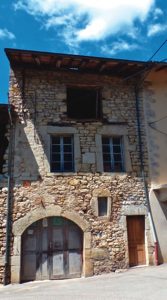
The Convent of the St Joseph Sisters where Jeanne Marie Chavoin and Marie Jotillon boarded when they arrived in Cerdon
In 1816, when his young brother was appointed as his curate, Pierre Colin did not know of the Marist project. As soon as Jean-Claude told him about it, he sent for Jeanne Marie Chavoin and Marie Jotillon, two women who wanted to commit themselves to religious life, but who had not found a religious congregation that seemed to suit them. They came to Cerdon in 1817 and Jeanne Marie became the housekeeper at the presbytery. Jeanne Marie was to become the Foundress of the Marist Sisters.
The presbytery, in which the Sisters lived before moving to their own house, was rebuilt by the Colin brothers in 1822.
The Marist Sisters began with three members, all from Coutouvre in the Diocese of Lyons: Jeanne Marie Chavoin (Mother St Joseph), Marie Jotillon and Marie Gardet. Jeanne-Marie wrote:
The beginning of the community took place in a little house situated at Cerdon, Bugey, in the diocese of Belley, under Monsignor Devie, Bishop of Belley, and the Fathers Colin, parish priest and curate of the said parish. Later these priests were placed in charge of the Society of Mary.
We came to this house on 25 October 1823. We lived here till 1 June 1824, and paid 18 francs rent for the time we were in occupation. It was in this house that we received our first postulant ... on 21 December 1823 ...
Let us come back to the history of the little house which we spoke of. Being unable to stay there any longer, we left it to take possession of a larger one, which we moved into on 1 June 1824.
Till then we had worn the same clothes we had when we were at home, as we had not yet a habit. But on the 6th of the same month the Bishop of Belley, passing through Cerdon, blessed habits of a light blue material for the three original members. From then on we wore a costume consisting of a light blue dress, a large kerchief of white muslin, and a broad rimmed muslin bonnet ...
Now we must say a few words about the second house we occupied in Cerdon, where we remained 13 months and paid 108 francs for rent. Although we had more room than in the first, we had much more to put up with, because we had continual contacts with an old widow who had let us her rooms, which communicated with ours. This widow was a person without religion, who insulted us and caused us every kind of annoyance.
At last God came to our help by sending us M. Ruivet, the vicar general, who came to pay us a visit. He was surprised to see us so cramped for room, although we were only 13. He told us it was impossible to stay any longer in this house, and that we must write at once to His Lordship to take us out of it (The Correspondence of Mother St Joseph, RMJ Doc. 99).
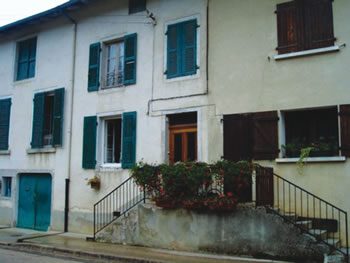
This is the second of the Sisters’ houses, the first one being abandoned after being destroyed twice by fire. The sisters moved in there on 1 June 1824, the first postulants then joined them, and they took on a few pupils. They lived in this house till 28 June 1825, when they left Cerdon for Belley
The sanctuary of the church of St John the Baptist at Cerdon was built in the 15th century, the central part was built in 1772 and extended in 1863. The clock tower was re-built in 1844, having been knocked down during the Revolution. The original statue of the Virgin and Child is at the back of the church on the left, overlooking a contemporary display of Marist history.
It was in this church that, on 8 December 1824, the clothing ceremony of the first Marist Sisters took place.
The Sisters, about 12 in number, left Cerdon for Belley on the night of 27-28 June 1825. The Colin brothers had moved to Belley five days earlier, having ministered in the town for almost nine years.
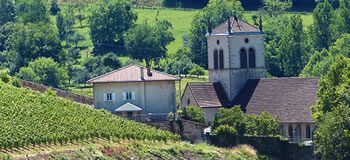
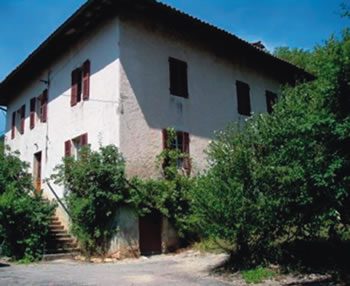
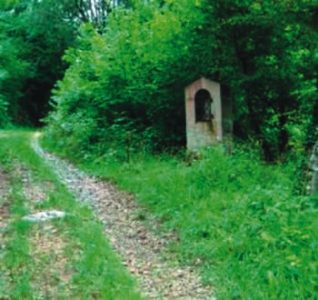
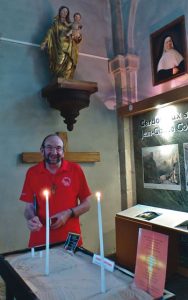
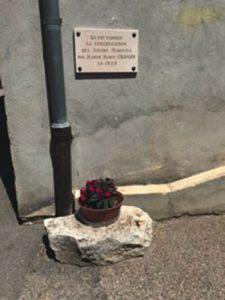
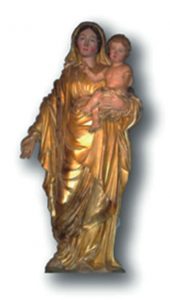
 Entries(RSS)
Entries(RSS)